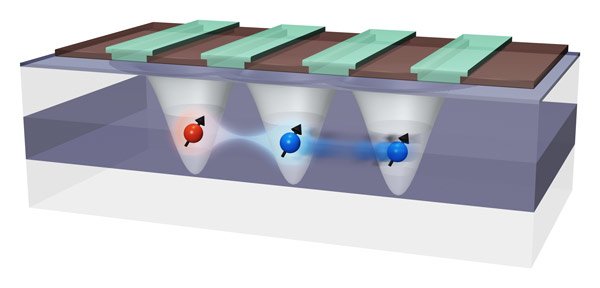| Mar 31, 2023 |
Connecting distant silicon qubits for scaling up quantum computers
(Nanowerk News) In a demonstration that promises to help scale up quantum computers based on tiny dots of silicon, RIKEN physicists have succeeded in connecting two qubits—the basic unit for quantum information—that are physically distant from each other (Nature Communications, "A shuttling-based two-qubit logic gate for linking distant silicon quantum processors").
|
|
Many big IT players—including the likes of IBM, Google and Microsoft—are racing to develop quantum computers, some of which have already demonstrated the ability to greatly outperform conventional computers for certain types of calculations. But one of the greatest challenges to developing commercially viable quantum computers is the ability to scale them up from a hundred or so qubits to millions of qubits.
|
|
In terms of technologies, one of the front-runners to achieve large-scale quantum computing is silicon quantum dots that are a few tens of nanometers in diameter. A key advantage is that they can be fabricated using existing silicon fabrication technology. But one hurdle is that, while it is straightforward to connect two quantum dots that are next to each other, it has proved difficult to link quantum dots that are far from each other.
|
 |
| Figure 1: RIKEN researchers have linked two distant qubits (red and blue spheres with black arrows gray cones on left and right) by coherent shuttling of one of the qubits (blue spheres). (Image: RIKEN Center for Emergent Matter Science)
|
|
“In order to connect many qubits, we have to densely cram many of them into a very small area,” says Akito Noiri of the RIKEN Center for Emergent Matter Science. “And it’s very hard to use wires to connect such very densely packed qubits.”
|
|
Now, Noiri and co-workers have realized a two-qubit logic gate between physically distant silicon spin qubits (Fig. 1).
|
|
“While there has been a lot of work in this area using various approaches, this is the first time that anyone has succeeded in demonstrating a reliable logic gate formed by two distant qubits,” says Noiri. “The demonstration opens up the possibility of scaling up quantum computing based on silicon quantum dots.”
|
|
To connect the two qubits, the team used a method known as coherent spin shuttling, which allows single spin qubits to be moved across an array of quantum dots without affecting their phase coherence—an important property for quantum computers since it carries information. This method involves pushing electrons through an array of qubits by applying a voltage.
|
|
Although the physical separation between the two qubits was relatively short, Noiri is confident that it can be extended in future studies. “We want to increase the separation to about a micrometer or so,” he says. “That will make the method more practical for future use.”
|

